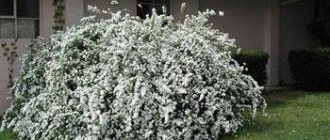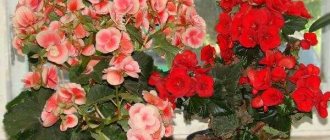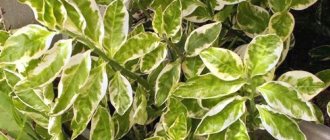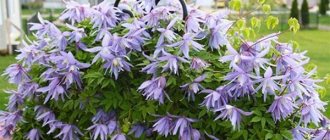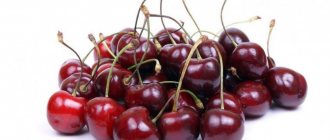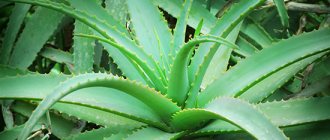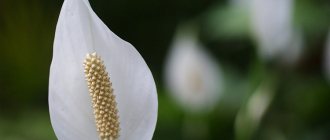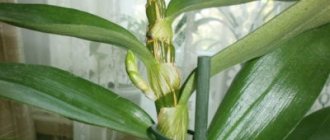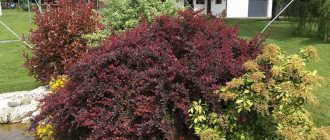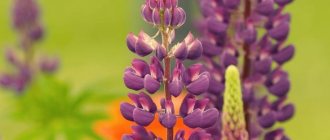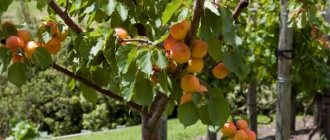Muscari blue muscari azureum photo
Everyone loves spring in their own way... for its tenderness, warm air, gentle rays of the sun, the first and very modest flowers. Muscari is one of the first to be ready to give people their beauty and charm. How much joy they give us when they emerge from the cold earth in early spring, replacing the primroses. White, sky blue, dark blue, pink bell-shaped flowers, forming a small pyramid, like porcelain, pressed closely together. This is what cheerful and touching muscari looks like.
Muscari - because it has an alluring, strong aroma of musk. And mouse hyacinth is due to its miniature size, as if for small mice, and its close relationship with real hyacinth. Viper onion - for the bulb that looks like a real onion and its toxicity. Near the clumps of these flowers you can often meet a whole family of vipers; they bask in warm meadows where muscari often grow.
Birds avoid pecking the viper onion - it is poisonous to them. Its English name means grape hyacinth - for its inflorescences, which in appearance resemble a bunch of grapes. The French call muscari earthen lilac. The variety of affectionate names hints that muscari viper onion has long been loved by many peoples of different countries.
Muscari white Muscaria White Beauty photo of flowering
Muscari came to Europe by chance back in the 17th century. In ancient times, off the coast of the Netherlands, during a storm, a merchant ship carrying strange goods from warm countries crashed on the reefs. The ship sank, and the bulbs were washed ashore by the waves and they sprouted. Thus, the inhabitants of Europe learned about the extraordinary flowers that can be grown from a tiny bulb.
These primroses look incredibly beautiful in the awakening garden, following the curves of the paths with cheerful streams. Curtains of muscari, similar to bouquets of small berries on long branches, like pieces of the sky, appear in flower beds here and there. Arrangers happily use them to compose their compositions.
General information
The root system of muscari is presented in the form of ovoid bulbs, which are covered with light outer scales. Their length is 1.5-3.5 centimeters, and their diameter can reach two centimeters. Basal linear leaves can reach a height of 17 centimeters. Usually their number does not exceed six pieces. They mainly appear with the onset of spring, but in some cases they can grow again in the autumn. The plant itself reaches a height of thirty centimeters. Below is a photo of muscari flowers.
It is distinguished by a leafless peduncle on which cylindrical, tubular or barrel-shaped perianths are located. They consist of several fused petals that are bent towards the edge. The flowers are distinguished by white or dark blue shades, are not very long, and reach only 0.5 centimeters. All flowers are collected together in apical or racemose inflorescences that grow no more than eight centimeters in length.
Muscari has a fruit presented in the form of a three-lobed winged capsule, which is shaped like a heart or a ball. Inside this box are collected black seeds. They retain their germination capacity for only one year. Two main advantages of this genus should be noted: muscari (photos are in the review) are not among the fastidious plants, and almost all types of plants are decorative.
Before you begin to study the features of growing muscari, you should find out its types and varieties, as well as their characteristics.
Types, varieties and varieties
As of 2014, a little more than 40 species of mouse hyacinth and muscari are known. About 20 species are found on the territory of Russia and the former Soviet republics. Most of them are grown as ornamental plants in flower pots at home and in garden plots.
Thanks to natural diversity and the work of breeders, muscari has many varieties and varieties. They differ in the shape and color of the buds, the length of the stem and leaves, and the flowering period. Not all mouse hyacinths are early bloomers; there are representatives of the genus whose flowers can be admired from late May to early June. You can also divide muscari according to popularity, into universal favorites and rare, little-studied species.
Muscari grapevine
Muscari grapevine
In various sources, in addition to the main name, you can find a description of a flower called racemose mouse hyacinth (Muscari botryoides). This type of muscari can most often be seen in flower beds and gardens. A small plant no higher than 12–15 cm long. Due to its modest size, the flower is recommended to be planted in open areas, in the foreground of the flower garden.
The head - the bulb has a rounded, elongated appearance, up to 3.5 cm in length and up to 2.5 cm in width. The leaves are narrow, linear, smooth, no more than 12 cm long and up to 1 cm wide. One bulb produces from two to six leaves. Small, miniature, barrel-shaped flowers of purple color, the edges of the flower are tiny, bent teeth, white. The flowers, in a racemose inflorescence no more than 12 cm long, are very densely planted on a strong peduncle.
The first buds bloom in early May. The flowers delight with their delicate, bright, unusual appearance for no more than one month. After which seeds are formed. Based on the species, various varieties with white and pink buds have been obtained.
Muscari latifolia
Muscari latifolia
In its natural environment it germinates and is found in a limited area in the western and southern forests of Turkey. Despite this, the flower has become widely known among garden flower lovers. Broad-leaved hyacinth is a very heat-loving species; it does not tolerate cold drafts, and in winters with little snow it can freeze. During the cold season, the plant needs additional shelter.
Starting from mid-spring, an arrow with a flower emerges from the bulb, the height of which can reach 25 cm. The inflorescence is tight, formed by about a hundred small, elongated, berry-shaped flowers. The inflorescence itself has a cylindrical shape, the color of which at the top is light purple, smoothly transitions to the base with a darker purple tint. Flowering duration is about 25–30 days.
Ovoid bulb up to 2 cm in diameter and up to 3 cm in length. The leaves are lanceolate, large compared to other species, up to 2.5 cm wide and up to 15–17 cm long. The leaf blades are strong, grow upward and seem to hug the peduncle; in appearance they resemble tulip leaves.
Muscari pale
Muscari pale
The species can rarely be found in garden plots and flower shops. In its natural environment, it grows on mountain slopes and subalpine meadows of the Caucasus and in eastern Turkey.
From one oval bulb-head, up to 3 cm long and up to 2 cm in diameter, up to six narrow, belt-shaped leaves grow up to 20 cm long and 0.5 cm wide. With the onset of cold weather, the leaves die off, becoming additional shelter for the winter. One bulb is capable of producing one, or less often two, peduncles up to 12 cm long. The inflorescence is formed from 40 small, elongated, oval flowers of pale blue color, almost white. You can admire the beautiful, delicate muscari flowers for 15–20 days in the second half of May. In culture, on the territory of Russia, it is extremely rare.
Muscari crested
Muscari crested
The only species that is unmistakably recognized among the representatives of the mouse hyacinth. The flower has an additional “tail,” “forelock,” or “tuft” at the top of the inflorescence. It blooms in late May - early June; the species is classified as a late-blooming mouse hyacinth. During flowering, the plant becomes very elongated. So, at the initial stage of the appearance of flowers, the height of the plant is no more than 25 cm. Upon completion of flowering, the stem with buds stretches to 50–70 cm.
From a large bulb, up to 4 cm in diameter, 4–6 narrow, belt-shaped leaves emerge. There are usually no more than two peduncles, at the top of each a multi-flowered, loose racemose inflorescence is formed. Small flowers of dark blue-violet color, cylindrical in shape on thin petioles. At the top of the stem, the buds are collected in a bunch and have longer pedicels, which is why they take on the appearance of a tuft. The apical flowers are sterile; seeds are formed after pollination of flowers with a brown-violet color and a light, beige edge. The species reproduces more by seeds than by daughter bulbs, which is why it often produces weeds.
In nature, crested muscari grows on the plains of Southern Europe and Southeast Asia.
Muscari Oshe or Muscari Tubergen
Muscari Oshe
Very beautiful and neat appearance. The inflorescence is small, formed by densely planted barrel-shaped flowers. A distinctive feature of the species is the color of the buds. At the top, the flowers are painted pale blue or light blue; at the bottom, most of the inflorescence, the flowers are of a more contrasting, dark color with white teeth. Flowering time is mid-April.
The bulb is medium-sized, ovoid, almost round, up to 1.5 cm in diameter and up to 2 cm in length. The leaves are narrow, linear, up to 15–18 cm long and up to 0.5 cm wide. Typically, one bulb produces up to three leaves and one peduncle up to 25 cm long. In winter, the leaves fall off, creating additional shelter for the winter.
Muscari Pretty
Muscari Pretty
Blooms in late winter - early spring. Because of this feature, it is practically not grown at home. In its natural environment it can be found in Southwestern Israel and coastal areas of the Mediterranean Sea.
The leaves are narrow, the edges bend, forming a narrow slit. The plant is miniature, together with the peduncle it is up to 15 cm in height. The ovoid inflorescence is formed by densely planted elongated flowers of a bright blue color with bent white teeth.
Muscari ambrosia
Muscari ambrosia
A type of muscari with interesting large buds collected on a strong, erect peduncle. Each bud has an elongated shape, narrowed at the end. Flowers on short petioles, planted loosely. There are 20–50 flowers on one peduncle, the colors of which change over time. So, at the beginning of flowering, the buds are purple, gradually turn pale, lighten, acquire a greenish-yellow tint, and at the end of flowering they become creamy.
The plant is small, about 10–25 cm in height. The leaves are dark green, linear, grooved, dense, up to 2 cm wide, equal to the length of the peduncle. The flowering period occurs in early to mid-spring.
Blue spike
Blue spike
A young variety from Holland, recognized as highly decorative, is often used in landscape design and floristry. Plant height is 20–25 cm. The racemose inflorescence is voluminous, double, formed by 150–170 small, blue, fragrant flowers. Unlike the natural species, the Blue spike variety has several buds on one stalk, which is why the inflorescence takes on the appearance of a “shaggy” panicle. All flowers are sterile. During the season, the plant forms up to 3 daughter bulbs. It blooms in May for 20–25 days. The growing season of leaves begins in the fall, which do not fall and overwinter under the snow.
Cantab
Muscari Cantab
The variety is a representative of the Armenian type of muscari. The maximum height of the plant during the flowering period is 20 cm. It blooms in May for one month. The flowers are bright blue with white teeth. The buds are elongated, tightly planted on a straight stem. The variety is quite popular, often used for landscaping gardens and growing at home.
Moschatum
A little-studied and rather rare species of mouse hyacinth. It was discovered in the mountains of Turkey and Northern Iraq. The height of the plant is no more than 20 cm. The leaves are narrow, up to 2 cm wide, long, belt-shaped, dark green. One inflorescence contains about 50 cylindrical flowers, tapering at the ends. The edges are jagged, bent outward. The species has been little studied and the question remains open as to which family it should be assigned to, either Hyacinth or Scilla.
Muscari neglected
Muscari neglected
In the literature, the species can be found under a different name - the unnoticed mouse hyacinth. At the beginning of the growing season, one or two bare peduncles emerge from the bulb. Only after this, leaves appear. The flowers are elongated, oval-tubular, dark blue or purple, and look like large grapes. The teeth are round and painted white. The inflorescence is oblong, dense, multi-flowered. Leaves, narrow, up to 15 cm long, up to 6 pcs. emerge from the ovoid bulb.
Muscari neglected is distributed over a vast territory of Europe, Asia and Russia. Mainly found in forest-steppe and steppe zones. In Russia, the species is included in many Red Data Books of the constituent entities of the Russian Federation: Belgorod, Volgograd, Kursk and Rostov regions.
Saffier
Muscari Saffier
Variety, representative of Armenian muscari. A rather heat-loving flower, it is extremely rare at Russian latitudes. In one season, one plant produces a whole group of “daughter” bulbs. Because of this feature, the variety quickly spreads and fills nearby areas. The flowers are dark blue, elongated, with white edges. Blooms in April - May. The height of the plant including the peduncle is about 20 cm.
Muscari azure
Muscari azure
In various sources, the species is found under the name azure muscari. The plant is 15–20 cm in height. The inflorescence is small, up to 8 cm long, formed by bell-shaped, cylindrical flowers of a soft blue color, and the color of the flowers varies depending on the location. So, in the upper part of the inflorescence the flowers are lighter, in the lower part they are darker. One inflorescence contains about 30–50 buds.
The plant blooms in a very interesting way - the lower flowers bloom first, creating the effect of a “ballerina’s skirt”. You can see this amazing fragrant flower in April - May. The species is native to the mountainous regions of northwestern Turkey.
Plumosum
Muscari comosum Plumosum
An interesting variety of crested mouse hyacinth. The flowers are very different from the usual appearance of muscari buds. Open inflorescences are formed by thread-like, lilac-violet, sterile flowers. The form is unstable in the middle zone.
Muscari large-fruited
Muscari large-fruited
The basal leaves are dark gray-green, narrow, with curved edges. The buds are large, cylindrical or barrel-shaped, red-brown in color, and as they open, acquire a yellow-green tint. The height of the flower including the peduncle is 15–20 cm.
Muscari Armenian
This species is most common due to its winter hardiness. It has another name - Colchian. Colchian muscari begins to bloom at the end of spring and this process lasts no more than three weeks. The name “mouse hyacinth” (photo below) is applicable specifically to this species. It has unusual inflorescences, the upper flowers of which can be safely called sterile, since they are lighter than the flowers located below, which have a dark blue tint and a white border. This muscari has a very pleasant aroma, which is impossible not to notice when being next to a flowering plant.
general description
Mouse Hyacinth is an early spring ephemeroid . Therefore, the plant is in a dormant state almost its entire life. The branches of the flower are elongated and shaped like a bulb. The diameter of the flowers is 1.0-2.5 cm. The branches reach a height of 5-7 cm. In spring, the plant throws out flower stalks and small leaves.
The total height of the flower varies from 9 to 35 cm depending on the subspecies. The leaves are narrow, elongated, lanceolate. Collected in a dense rosette next to the root system. The veins are even, weakly expressed, parallel. Leaf blades in the form of grooves. As they grow, the leaves begin to bend strongly.
Find out from the video how to properly plant mouse hyacinth in open ground and how to care for the plant:
Muscari crested
A very original plant that will decorate any garden or flower bed. If you want to find this species in natural conditions, then go searching in dry forest edges or meadows. The peduncle of this plant resembles a fluffy purple tuft. The peduncle has the shape of an arc. To decorate your site in a truly original way, plant crested muscari on lawns and lawns where ground cover grasses are grown.
This is not a complete list of types and varieties of muscari with photos that exist today, but the types described above are the most popular and unpretentious.
Application
Muscari contains many useful substances that have found their use in medicine and cosmetology.
ethnoscience
Infusions from the plant are used as antiseptic and anti-inflammatory agents, helping with severe stress and neuroses.
The essential oil of the flower helps with diseases of the bronchial system.
Cosmetology
The high content of essential oils in the plant allows it to be used in cosmetology. Creams, tonics and balms are made from plant extracts.
Landscape design
Landscape designers and florists love Muscari flowers for their high decorative properties. In combination with other early crops, beautiful spring compositions, alpine hills and rocky gardens are created.
Features of cultivation
It should be noted that various types of muscari (see photo in the article) are very popular among experienced and novice gardeners. They can be grown not only near borders, but also in rock gardens, multi-tiered flower beds, and they can be combined with various spring flowers, creating wonderful compositions in your garden. Daffodils and tulips look good against the background of muscari; the main thing is to choose the right color scheme. You can also plant muscari near orange hazel grouse. This composition will be very bright and attractive to the eye.
Muscari are not much different from other early flowering spring plants. The first flowers appear on them even at a time when buds are just beginning to appear on the trees, and leaves are not worth even dreaming about. Based on this, we can conclude that these flowers can be planted anywhere, since nothing will prevent them from receiving a sufficient amount of sunlight.
At the beginning of the article it was said that muscari is a perennial plant, so it grows in one place for more than one year. Based on this, you should not plant a flower next to those flowers that need annual replanting. As for the soil, it is better to choose loose and fertile soil with good water permeability. Also try to choose a site that will be located on a small hill, which is necessary so that water does not stagnate in the roots and strong wind does not blow on the flowers.
Muscari in landscape design
Muscari look good in a flower bed, as can be seen in the photo, and are also ideal for creating rock gardens and borders. Flowers need to be planted in whole groups, which accentuates attention.
Muscari goes well with tulips, hazel grouse, daffodils and other early flowering spring crops.
Muscari gets along with many garden crops
Disembarkation time
Muscari should be planted in the fall, no later than the end of October. Disembarkation is carried out in groups. If you are replanting existing plants, it is recommended to replant no more than once every five years. As for the purchased bulbs, they need to be carefully inspected when purchasing, and also pay attention to the shoots: they must have a healthy appearance; rot or other damage must not be present. If you didn’t have time in the fall, then try to buy muscari bushes in April that are already blooming. This method of landing also has a good chance of success.
Answers on questions
Why doesn't it bloom?
If the plant stops blooming, this is the first sign that it is time to replant it or separate the bulbs.
What to do if they sprouted in the fall?
Some varieties of Muscare quickly develop and germinate when planted in autumn. This does not threaten the flowers with death; they will quietly overwinter with leaves, and in the spring they will actively begin to grow.
Landing technology
Before planting plant bulbs in the ground, inspect them thoroughly to make sure they are free of diseases and damage. If there are damaged areas, they should be removed immediately.
For the purpose of prevention, the bulbs should be disinfected. First, they are placed in a two percent solution of karbofos for thirty minutes, after which they are placed in a one percent solution of potassium permanganate for the same period of time.
You need to prepare for planting bulbs in advance. To do this, the day before planting, you need to water the prepared holes well. Moistening should take place so that the entire soil layer is wet. It is recommended to use river sand as a drainage layer.
Large bulbs are deepened by seven centimeters with a distance between them of 5-10 centimeters. As for the smaller ones, they are placed at a distance of 2-3 centimeters from each other, and deepened only three centimeters into the soil.
Forcing bulbs
You can please yourself with fragrant inflorescences at any time of the year. To do this, you need to artificially create conditions for muscari to bloom. Immediately after the foliage withers, the bulbs are dug up and dried in a cool room. They are then placed in containers with peat or sand for storage. Initially, the air temperature is maintained at +15…+17°C. After a few weeks, the bulbs are transferred to a room with a temperature of +5...+9°C for 3-4 months. You can use the vegetable compartment in the refrigerator.
Approximately 3 weeks before the expected flowering, the bulbs are planted in pots with fertile, loose soil to a depth of about 2 cm. The top should remain on the surface. Plants are transferred to a well-lit place with a temperature of about +10°C. After a couple of days, the temperature is raised to +15°C. After this, the leaves actively grow, and after 2 weeks a peduncle appears.
Features of garden care
There should not be any difficulties when caring for muscari in the garden. This applies to both experienced and novice gardeners. In general, this flower can be safely called a training flower, since due to its unpretentiousness it is perfect for beginners. Muscari needs to be watered only when it enters its growing season, but often this period passes while the soil is still moist, after rains and melting snow. Therefore, you won’t have to water the flowers particularly often. During the muscari dormant period there will be quite enough rain. Regular watering will be required only if there was no snow in the winter and the spring was dry.
What kind of soil is needed
Pay attention to the soil. If your site is not particularly fertile, you will need to fertilize it with organic fertilizers. Compost or humus is perfect for this. It is recommended to carry out such fertilizing in the fall, during digging. Please note that for every square meter you will need about five kilograms of fertilizer. If such fertilizing and digging are carried out regularly, then muscari will be able to grow in one place for about ten years and still feel great. However, over time you will still have to undergo a transplant.
Bloom
As already mentioned, muscari blooms for approximately three weeks, in some cases perhaps a little longer. No special care for the plant is required during this period. The main thing is to loosen the soil a little immediately after moistening the soil. When weeding, you need to be as careful as possible so as not to damage the bulbs. You should also remove weeds from the beds and remove inflorescences that have already faded. They not only spoil the aesthetic appearance of your flowerbed, but also prevent the plant from developing and blooming normally. Monitor the quality of the flowers; if it deteriorates, you should immediately replant the plants.
Medicinal properties
Muscari petals have beneficial properties - they contain esters, flavonoids, organic acids, and ascorbic acid.
The plant is used as a wound-healing, bactericidal and aphrodisiac. Traditional medicine in Asian countries uses essential oil to treat bronchitis, massage, aromatherapy, colds, and insomnia.
The perfume industry also did not ignore this fragrant flower; its notes create the aroma of perfumes and are used in cosmetology.
At home, bouquets of mouse hyacinths are placed not only for beauty: the plant repels flies, mosquitoes, and midges. Cannot be used internally, the plant is poisonous.
Transfer rules
Dividing the mother bulb is a vegetative method of propagation. This transplantation is carried out in the fall, starting from mid-October until the end of the month. This procedure is carried out no more often than once every five to six years, provided that the plant was in one place for this period of time. However, you yourself will understand when to transplant. The flowerbed itself will “tell” you about it.
To transplant the bulbs, you should remove them from the ground and separate the children from them. Their number can exceed 30 pieces. As for the landing method, it was described above.
Reproduction
The vegetative method of propagation is not the only one for muscari. These plants also reproduce well by seeds, by self-sowing. But if you do not want the flowers to spread randomly throughout the flowerbed, then all faded flower stalks should be removed immediately. You can leave only a few of them to collect seeds from them later. As mentioned earlier, ripened and collected seeds can germinate only within one year. They should be deepened no more than 1-2 centimeters. The shoots look like thin strings that inform the gardener that the formation of bulbs has begun. Flowering should be expected no earlier than three years after planting.
Conditions for hyacinth
The optimal temperature for growth is above 18°C. This representative of the flora loves warm sunny weather. Can withstand frosts down to minus 15°C.
Mouse Hyacinth prefers bright lighting . Excellent exposure to sunlight. It can grow in the shade, but in this case flowering will be poor. When grown at home in winter, it can do without additional lighting.
Reproduction
The plant reproduces by seeds. The method of distribution of planting material is myrmecochory with the help of ants. The seeds of this plant have elaiosomes - fat-containing appendages.
It is thanks to these enzymes that the plant attracts ants. Insects pick up flower seeds and bring them to their anthill.
Insects eat only the elaiosome, the top of the planting material. And the seeds themselves are thrown outside the anthill. In warm weather, seeds begin to grow in new territory. The plant also reproduces vegetatively - by daughter bulbs. They are kept in a solution of a growth stimulator and planted in the ground.
Bloom
This plant blooms in mid-spring , depending on the region of growth.
The flowers of this representative of the flora look like small bells. They are found in dense inflorescences. The tassels reach no more than 9 cm in length. Therefore, this plant is compared to lilies of the valley. Depending on the subspecies, the perianths have a snow-white, amber, soft pink or purple hue.
Look at the photo to see how beautiful hyacinths bloom and what colors their inflorescences come in:
The upper flowers are sterile. Their aroma attracts insects that pollinate the plant. Therefore, Mouse Hyacinth belongs to entomophilous pollination. The perianth is simple in shape, actinomorphic. It has 6 fused petals in the shape of a barrel. The flower has 6 stamens with purple or blue anthers. Single pistil. The ovary is in the upper part. Has 3 carpels. The fruit of the plant is in the form of a three-chambered box.
Diseases and pests
Various types and varieties of muscaria flowers (photo in the article) can also be attacked by pests and suffer from various ailments. Most often, muscari is bothered by mosaic, which is a consequence of the appearance of a virus such as onion yellow dwarf. The symptoms of mosaic cannot be ignored, since it appears in the form of a green mosaic on the leaves, the plant produces shortened flower stalks, the leaves become narrower, and the growth of the diseased specimen is greatly slowed down.
The plant can also become infected with the usual cucumber mosaic, which appears on the leaves in the form of pale green streaks and spots. The carrier of viruses is aphids; if the mosaic gets into the bulb, it will begin to develop there. That is why there can be no talk of any treatment. All damaged specimens are dug up and simply burned, since they cannot be cured.
In this case, it is necessary to fight aphids, the main carrier of the disease. But fighting these insects is quite simple. You will need to dilute two teaspoons of liquid soap in two glasses of water and spray the plants with this solution.
Muscari can also be attacked by spider mites. It should be combated with the help of various drugs that can be purchased in the store.
Planting and caring for muscari
- Planting: autumn, October.
- Bloom: spring.
- Lighting: bright sunlight, partial shade.
- Soil: any.
- Watering: if the winter was snowy or the spring was wet, then watering is not needed at all.
- Top dressing: when digging the site, add humus or compost at the rate of 5 kg per m².
- Reproduction: self-seeding and vegetative: separation of children from the mother bulb and planting them in the ground.
- Pests: aphids, spider mites.
- Diseases: onion yellow dwarf and cucumber mosaic viruses.
Read more about growing muscari below.
Muscari (lat. Muscari) , or viper onion , or mouse hyacinth , is a genus of bulbous perennial plants of the Asparagaceae family, although previously it was classified as a member of the Hyacinth or Liliaceae family. There are about 60 species, naturally growing among shrubs, on forest edges and on the slopes of mountains in Central and Southern Europe, the Caucasus, Asia Minor, Crimea and the Mediterranean. Muscari flowers are one of the earliest spring flowers, often grown as cut flowers. The muscari plant has a pleasant and quite strong aroma. Garden muscari flowers, miniature and graceful, decorate lawns; they are used in ridges and rock gardens, and also as border plants.
